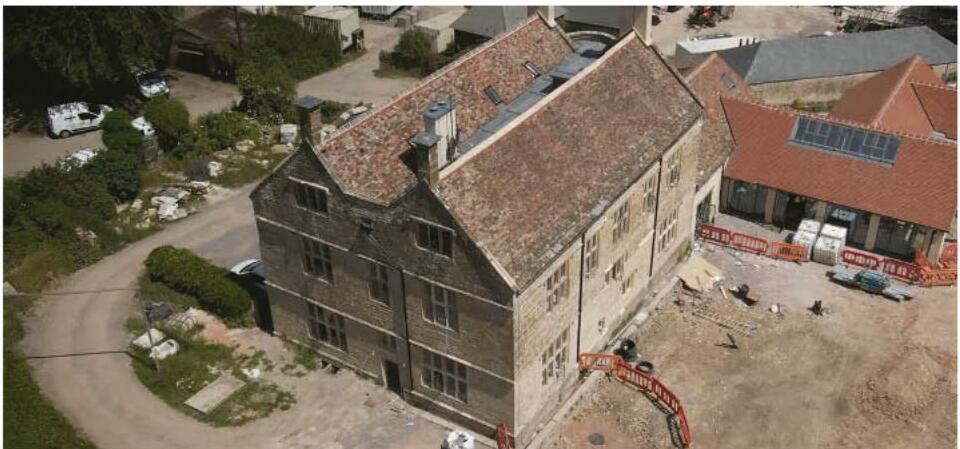
SINCE 1798, R. Moulding & Co has been employing traditional craftsmanship and materials to create some of Britain's most beautiful houses. For the past six years, the company has been included in COUNTRY LIFE's Top 100 list of Britain's best craftspeople.
Why do materials play such a vital role in a sensitive restoration?
Every successful project is a balancing act between aesthetics, heritage and the demands of 21st-century living. Both new and reclaimed materials have a role to play in any project. It's essential that materials are sympathetic to the original construction of a building, respecting both its period and the vernacular style. A new stone floor, for example, should use a local material, not a cheaper, less appropriate alternative from beyond our shores. Not only does this minimise the carbon footprint, it will also complement the look and feel of building.
However, this isn't only an aesthetic and environmental consideration; in old buildings, the use of correct materials plays an important role in the management of damp.
Where possible, is it always better to use reclaimed materials than new?
When used appropriately, reclaimed materials will create the immediate impression of age and offer the additional benefit of employing something that would otherwise be destined for landfill. However, great care is required; reclaimed materials are expensive and are usually purchased 'as-seen' (although many good reclamation specialists should replace any defective materials). Inevitably, reclaimed materials have a high risk of performance failure, particularly if required to provide a weathering function in an exposed location, notably on a roof. This will also raise the question of who will be liable for the cost of replacing faulty materials. Reclaimed bricks are likely to come from multiple sources, creating additional problems when they are laid.
هذه القصة مأخوذة من طبعة August 10, 2022 من Country Life UK.
ابدأ النسخة التجريبية المجانية من Magzter GOLD لمدة 7 أيام للوصول إلى آلاف القصص المتميزة المنسقة وأكثر من 9,000 مجلة وصحيفة.
بالفعل مشترك ? تسجيل الدخول
هذه القصة مأخوذة من طبعة August 10, 2022 من Country Life UK.
ابدأ النسخة التجريبية المجانية من Magzter GOLD لمدة 7 أيام للوصول إلى آلاف القصص المتميزة المنسقة وأكثر من 9,000 مجلة وصحيفة.
بالفعل مشترك? تسجيل الدخول

A trip down memory lane
IN contemplating the imminent approach of a rather large and unwanted birthday, I keep reminding myself of the time when birthdays were exciting: those landmark moments of becoming a teenager or an adult, of being allowed to drive, to vote or to buy a drink in a pub.

The lord of masterly rock
Charles Dance, fresh from donning Michelangelo’s smock for the BBC, discusses the role, the value of mentoring and why the Sistine chapel is like playing King Lear

The good, the bad and the ugly
With a passion for arguing and a sharp tongue to match his extraordinary genius, Michelangelo was both the enfant prodige and the enfant 'terribile’ of the Renaissance, as Michael Hall reveals

Ha-ha, tricked you!
Giving the impression of an endless vista, with 18th-century-style grandeur and the ability to keep pesky livestock off the roses, a ha-ha is a hugely desirable feature in any landscape. Just don't fall off

Seafood, spinach and asparagus puff-pastry cloud
Cut one sheet of pastry into a 25cm–30cm (10in–12in) circle. Place it on a parchment- lined baking tray and prick all over with a fork. Cut the remaining sheets of pastry to the same size, then cut inner circles so you are left with rings of about 5cm (2½in) width and three circles.

Small, but mighty
To avoid the mass-market cruise-ship circuit means downsizing and going remote—which is exactly what these new small ships and off-the-beaten track itineraries have in common.

Sharp practice
Pruning roses in winter has become the norm, but why do we do it–and should we? Charles Quest-Ritson explains the reasoning underpinning this horticultural habit

Flour power
LONDON LIFE contributors and friends of the magazine reveal where to find the capital's best baked goods

Still rollin' along
John Niven cruises in the wake of Mark Twain up the great Mississippi river of the American South

The legacy Charles Cruft and Crufts
ACKNOWLEDGED as the ‘prince of showmen’ by the late-19th-century world of dog fanciers and, later, as ‘the Napoleon of dog shows’, Charles Cruft (1852–1938) had a phenomenal capacity for hard graft and, importantly, a mind for marketing—he understood consumer behaviour and he knew how to weaponise ‘the hype’.